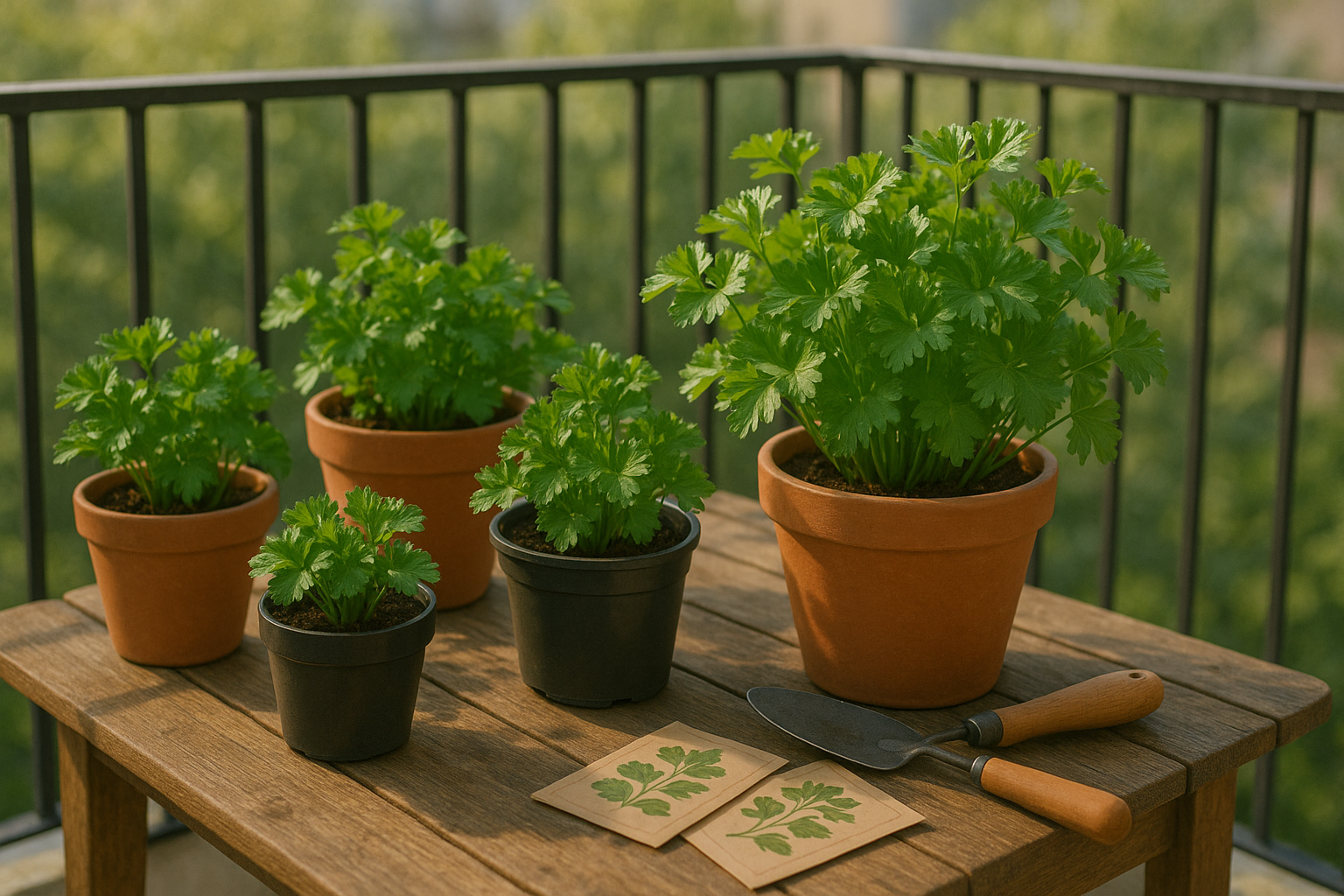Growing Parsley in Pots or Containers – Complete Guide
Growing parsley in pots or containers is a practical choice for gardeners with limited space or those who want fresh herbs within easy reach. Choose a pot at least 8 inches deep with good drainage, and fill it with high-quality potting mix.
Sow seeds thinly and keep the soil moist—parsley seeds are slow to germinate and can take up to three weeks, so patience is key. Place your container in a spot that receives at least six hours of sunlight daily, like a sunny balcony or windowsill.
To encourage healthy, bushy growth, regularly snip parsley leaves, always cutting the outer stems first. If your parsley becomes leggy or turns yellow, it may need a little fertilizer or more sunlight.
Follow these simple steps, and you’ll have a lush supply of flavorful parsley within arm’s reach all season long.
Choosing the Right Pot and Parsley Variety
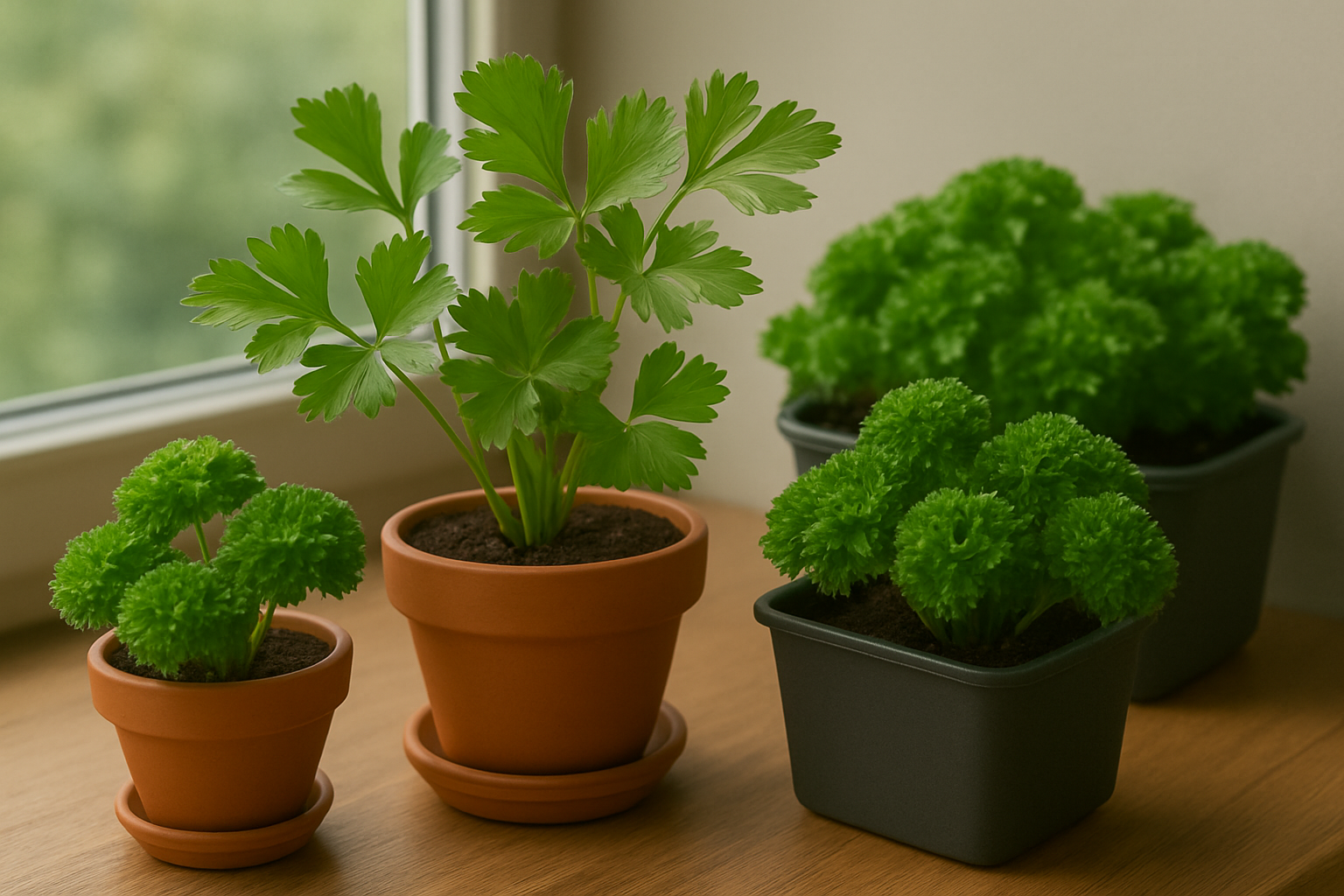
Picking the right pot for growing parsley can make a big difference in how healthy your plants are and how easy they are to care for. Parsley doesn’t need a huge container, but giving it enough room for its roots helps prevent overcrowding and soggy soil. Aim for a pot that’s at least 6–8 inches deep and wide—you can go bigger if you plan to grow multiple plants together.
Always pick a pot with drainage holes to stop water from pooling at the bottom; parsley hates “wet feet,” which leads to root rot. Terracotta pots are classic and let roots breathe, but lightweight plastic pots work just as well for beginners as long as they have good drainage.
When it comes to parsley varieties, both flat-leaf (Italian) and curly parsley can thrive in containers, but flat-leaf tends to be more robust, faster-growing, and better suited to the limited space—plus, it’s often the chef’s favorite for its strong flavor and ease of chopping. Curly parsley is a bit more compact and adds a decorative touch, making it a fun choice for windowsills or mixed herb pots.
To get started, shop for seeds or seedlings from a reputable nursery or garden center—look for organic or non-GMO labels for the healthiest plants. Growing parsley from seed can be slow, with germination taking up to three weeks, but it’s inexpensive and offers a wider selection of varieties. Transplants or seedlings provide a quick head start but might shock easily during repotting.
If you’re new to gardening or want instant results, start with healthy seedlings; if you enjoy the full growing process, planting seeds is rewarding and budget-friendly.
Preparing the Perfect Potting Mix
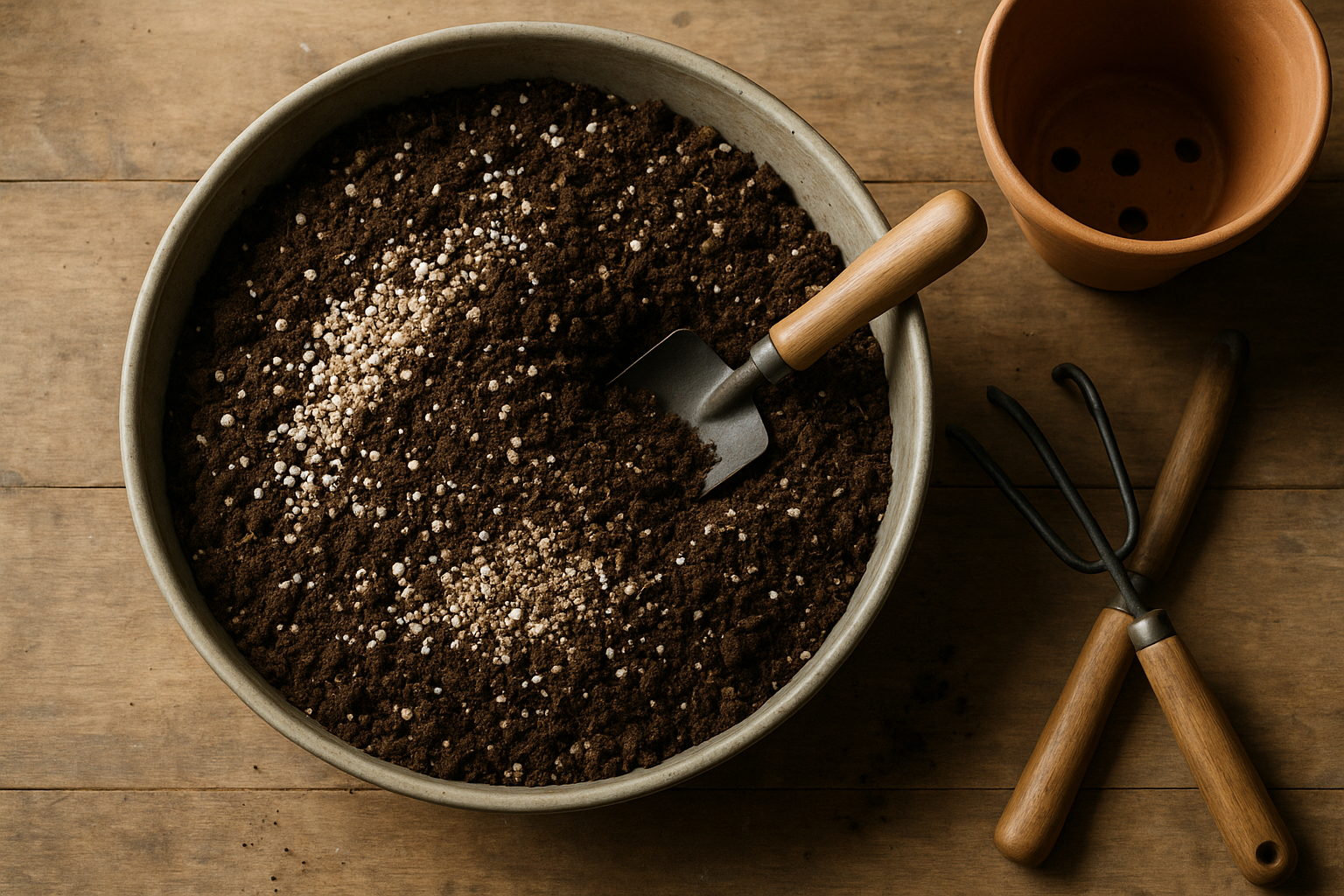
When growing parsley in containers, using potting soil instead of garden soil offers clear advantages. Potting soils are lighter, drain better, and resist compacting, giving parsley roots more space and oxygen to thrive. Unlike heavy garden soil, which can clump in pots and hinder growth, a quality potting mix—especially when blended with compost for nutrients, perlite for aeration, and vermiculite to retain moisture—creates an ideal environment for herbs.
Aim for a soil pH between 6.0 and 7.0; parsley prefers a slightly neutral balance. If your mix is too acidic, add garden lime; if it’s too alkaline, work in some peat moss to bring the pH down.
Before filling your pots, check this quick list:
- Ensure your container has drainage holes.
- Layer the bottom with gravel or broken pottery for extra drainage.
- Fill with loose, mixed soil—never pack it in tightly, as this can suffocate roots.
- Water lightly after planting to settle the mix.
By focusing on these steps, you’ll avoid common pitfalls like soggy roots and compacted soil, giving your parsley the healthiest possible start in its new home.
Sowing and Planting Parsley
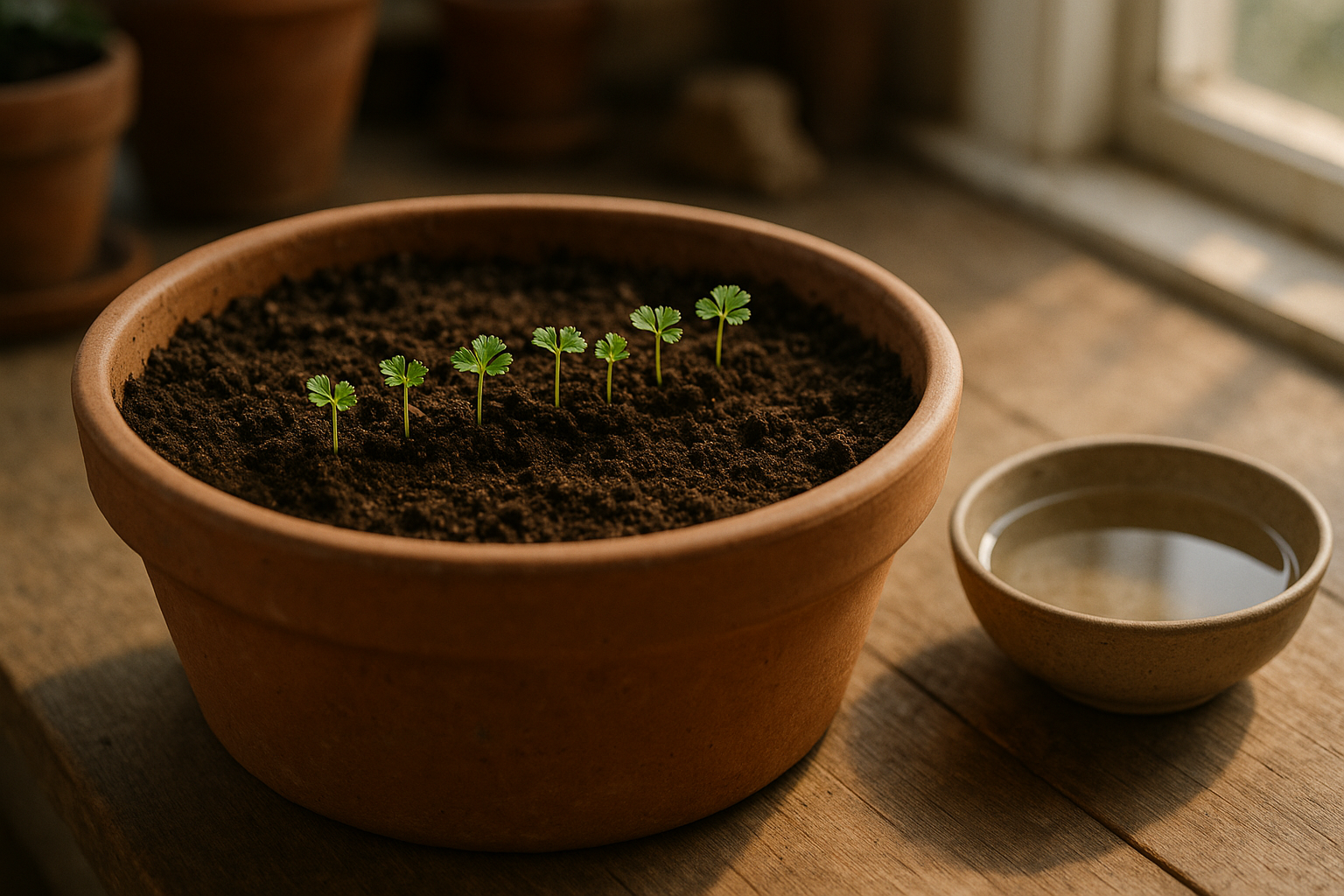
Starting parsley from seed is rewarding but requires patience, as the tiny seeds can take up to three or four weeks to germinate. To boost your chances, soak seeds in warm water for 24 hours before planting—this helps soften the hard seed coat and encourages quicker sprouting.
For a head start, sow seeds indoors 6–8 weeks before your last expected frost, or direct sow outdoors once soil temperatures stay above 50°F (10°C).
If starting indoors, fill seed trays or small pots with seed-starting mix, then sprinkle seeds about 1/4 inch deep; lightly press them in and cover with a thin layer of soil. Outdoors, space rows 10–12 inches apart and plant seeds about 1 inch apart within rows.
For pots, sow 6–8 seeds per 8-inch container, thinning to three of the strongest seedlings later.
Parsley prefers moist, well-drained soil and lots of sunlight—ideally six hours a day. Seeds need warmth, so place containers near a sunny window or under grow lights if indoors. Covering trays with plastic wrap or a humidity dome helps maintain moisture until seedlings appear.
By preparing seeds correctly and providing steady warmth and light, you’ll be rewarded with healthy parsley plants perfect for kitchen use.
Light, Water, and Fertilizing – Daily Parsley Care
Parsley thrives with at least six hours of sunlight each day. If you’re growing it outdoors, choose a spot that gets plenty of morning sun and some light afternoon shade, especially in hot summer climates. Indoors, place your pot in a south-facing window or under a full-spectrum grow light for up to 12 hours daily to mimic natural conditions.
When it comes to watering, parsley prefers consistently moist but not soggy soil. Water when the top inch of soil feels dry to the touch. Over-watering signs include yellowing leaves and a limp appearance, while under-watered parsley will wilt and have brittle leaves. A simple way to check moisture is to stick your finger into the soil; if it feels dry past your first knuckle, it’s time to water.
Fertilize parsley every three to four weeks, starting two weeks after sprouting. Use an organic liquid fertilizer diluted to half strength to keep growth steady without risking fertilizer burn. Liquid fish emulsion or seaweed extract are great options.
Mulching the base with shredded bark, straw, or a thin layer of washed pebbles can make a big difference. Mulch helps retain soil moisture, regulate temperature, and reduce weed growth, saving you time on daily maintenance. Just be sure to avoid piling mulch directly against the stems to keep air circulating and prevent rot.
With this simple care routine—thoughtful light placement, a daily moisture check, gentle organic feeding, and a bit of mulch—your parsley patch will stay healthy, lush, and vibrant for weeks of flavorful harvests.
Keeping Parsley Healthy
Growing parsley in containers is convenient, but keeping plants healthy means staying alert for pests and common problems. Aphids and spider mites are two major pests to watch for—these tiny insects often gather on stems and under leaves, sucking sap and leaving wilted or yellow patches.
To combat them, try spraying your parsley with a strong stream of water to dislodge pests, or use a homemade solution of mild soapy water as a natural insecticide. Predatory insects like ladybugs can also help keep populations in check.
Diseases such as root rot and fungal infections, including powdery mildew, often result from excess moisture and poor airflow. To prevent these, plant parsley in well-draining potting mix and avoid letting water pool at the base of the container. Water in the morning so leaves dry out quickly, and space plants to promote airflow.
If you notice yellowing leaves, the cause could range from overwatering to nutrient deficiency. Ensure your container drains freely and feed plants with a balanced, diluted liquid fertilizer every few weeks. Slow growth often points to low light—parsley thrives with at least 4-6 hours of sun daily—while legginess (tall, spindly stems) suggests the same. Regularly pinch back stems to encourage fuller growth.
Most importantly, inspect parsley frequently—catching issues early makes fixing them much easier and keeps your harvest lush and productive.
Harvesting and Using Your Parsley
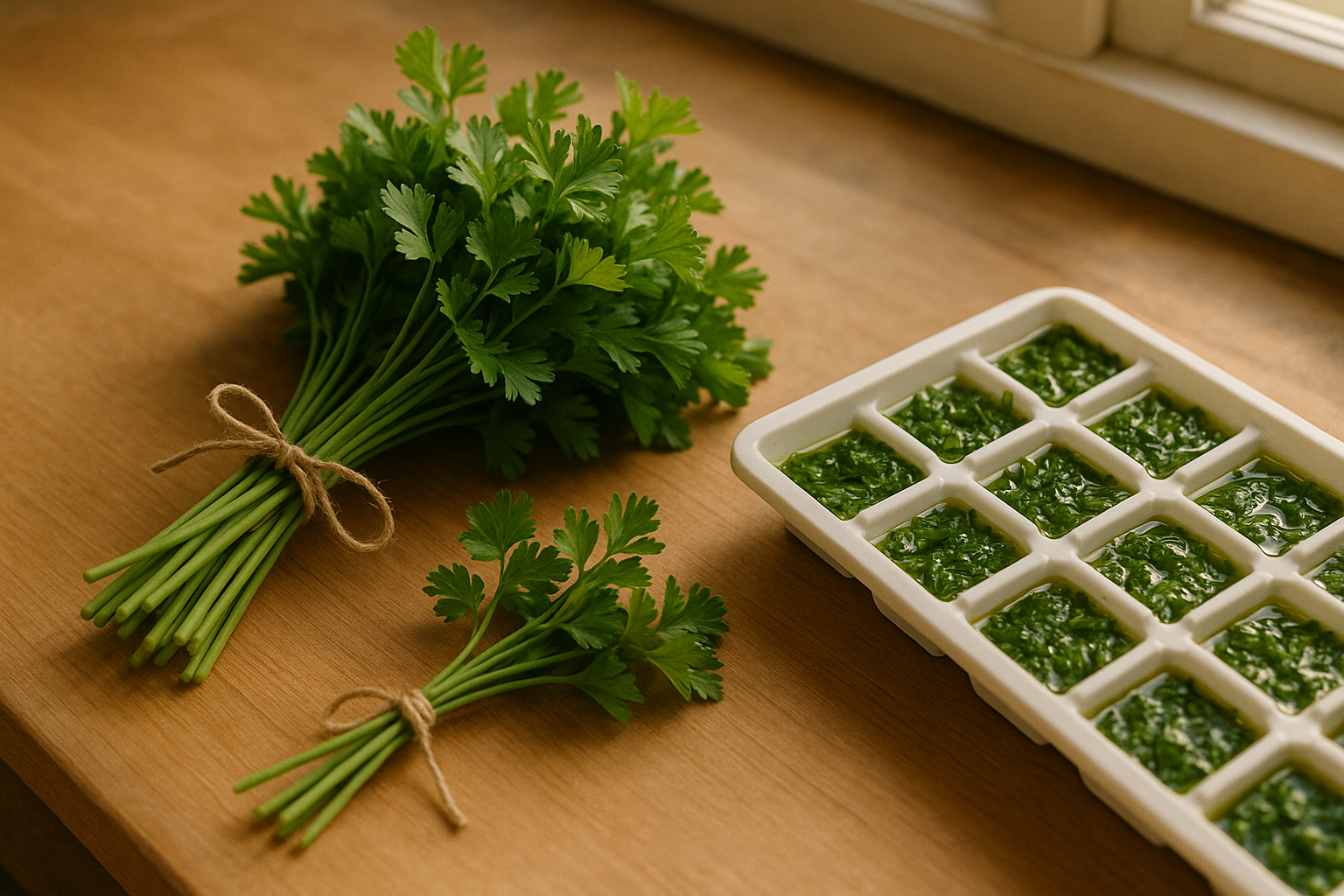
Harvesting parsley at the right time ensures the best flavor and encourages healthy regrowth. The optimal moment to harvest is once your parsley has at least three segments of leaves on each stem, usually a few weeks after planting.
For best results, snip the outer stems at the base—never just pick leaves from the top. This method stimulates the plant to grow new shoots from the center and keeps it bushy. Use clean, sharp scissors or garden shears to avoid damaging the stems.
Frequent harvesting, ideally once a week, not only keeps your kitchen stocked but also results in a fuller, healthier plant throughout the season. After cutting your parsley, wrap the stems in a damp paper towel, place them in a perforated bag, and refrigerate; this keeps them fresh for up to a week.
For longer-term storage, chop the leaves and freeze them in ice cube trays with a little water or olive oil, or dry small bunches by hanging them upside down in a well-ventilated area.
Homegrown parsley’s vibrant flavor shines in salads, homemade pesto, soups, and as a finishing garnish. With regular harvesting, you’ll enjoy a steady supply for your favorite recipes while helping your parsley thrive all season long.
Year-Round and Succession Growing
To maintain a steady supply of fresh parsley in your container garden, try succession sowing—plant seeds or young starts every three to four weeks. This way, you’ll always have plants at different stages, so when one batch is winding down, another is ready to harvest.
For overwintering, if you live in a mild climate, simply move containers to a sheltered spot and mulch lightly to protect roots from light frost. In colder areas, bring pots indoors before the first hard freeze; a sunny windowsill or grow lights will keep parsley producing through the winter.
As parsley matures, its leaves can become bitter and less productive after the second year. Replace older plants by starting fresh seeds or seedlings each season. When swapping out plants, don’t forget to refresh the potting mix: gently remove the top few inches and add new, nutrient-rich soil or compost. This encourages healthy root development and prevents disease buildup.
Stay mindful of regular watering—avoid waterlogging—and feed every few weeks with a balanced liquid fertilizer. By rotating plantings, updating soil, and giving your containers some seasonal TLC, you’ll enjoy vibrant parsley harvests all year long, no matter the weather.
